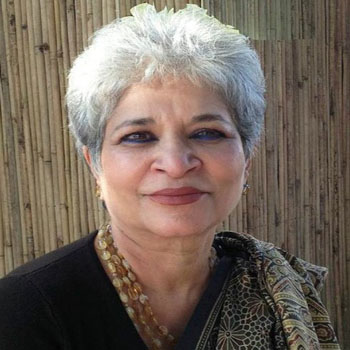
Book Review: ‘Phulkari From Punjab’ Traces Every Thread of Punjab’s Embroidery
Tyabji, Laila
September, 2023
Sometimes repetitive, occasionally slipping into cliche, Anu Gupta and Shalina Mehta's book is nevertheless an important addition to the documentation of Indian embroidery.
[caption id="attachment_198003" align="alignnone" width="747"] The phulkari was both an art form and a powerful means of self-expression for otherwise non-literate Punjabi women. Photo: Author provided[/caption]
The phulkari was both an art form and a powerful means of self-expression for otherwise non-literate Punjabi women. Photo: Author provided
The sizzling, vibrant orange, ochre and pink satin-floss geometrics of Punjabi phulkari, once seen can never be forgotten.
That redoubtable 18th century Indian Memsaab, Flora Anne Steele, talking about the Phulkari embroidery of Punjab, called it “A work of faith, savouring somewhat of sowing in the red-brown soil.”
There can never be enough books on Indian Embroidery! No country has as many traditions and techniques, varying from region to region, community to community, as India, each uniquely itself but also unmistakably part of the Indian aesthetic. Phulkari too, its origins in Central Asia, was transformed by the culture and rustic dynamism of the women of Punjab into something distinctively Punjabi.
Anu Gupta and Shalina Mehta, the authors of Phulkari from Punjab: Embroidery in Transition, are both from the Department of Anthropology at Punjab University, Cha...
The phulkari was both an art form and a powerful means of self-expression for otherwise non-literate Punjabi women. Photo: Author provided[/caption]
The phulkari was both an art form and a powerful means of self-expression for otherwise non-literate Punjabi women. Photo: Author provided
The sizzling, vibrant orange, ochre and pink satin-floss geometrics of Punjabi phulkari, once seen can never be forgotten.
That redoubtable 18th century Indian Memsaab, Flora Anne Steele, talking about the Phulkari embroidery of Punjab, called it “A work of faith, savouring somewhat of sowing in the red-brown soil.”
There can never be enough books on Indian Embroidery! No country has as many traditions and techniques, varying from region to region, community to community, as India, each uniquely itself but also unmistakably part of the Indian aesthetic. Phulkari too, its origins in Central Asia, was transformed by the culture and rustic dynamism of the women of Punjab into something distinctively Punjabi.
Anu Gupta and Shalina Mehta, the authors of Phulkari from Punjab: Embroidery in Transition, are both from the Department of Anthropology at Punjab University, Cha...
 The phulkari was both an art form and a powerful means of self-expression for otherwise non-literate Punjabi women. Photo: Author provided[/caption]
The phulkari was both an art form and a powerful means of self-expression for otherwise non-literate Punjabi women. Photo: Author provided
The sizzling, vibrant orange, ochre and pink satin-floss geometrics of Punjabi phulkari, once seen can never be forgotten.
That redoubtable 18th century Indian Memsaab, Flora Anne Steele, talking about the Phulkari embroidery of Punjab, called it “A work of faith, savouring somewhat of sowing in the red-brown soil.”
There can never be enough books on Indian Embroidery! No country has as many traditions and techniques, varying from region to region, community to community, as India, each uniquely itself but also unmistakably part of the Indian aesthetic. Phulkari too, its origins in Central Asia, was transformed by the culture and rustic dynamism of the women of Punjab into something distinctively Punjabi.
Anu Gupta and Shalina Mehta, the authors of Phulkari from Punjab: Embroidery in Transition, are both from the Department of Anthropology at Punjab University, Cha...
The phulkari was both an art form and a powerful means of self-expression for otherwise non-literate Punjabi women. Photo: Author provided[/caption]
The phulkari was both an art form and a powerful means of self-expression for otherwise non-literate Punjabi women. Photo: Author provided
The sizzling, vibrant orange, ochre and pink satin-floss geometrics of Punjabi phulkari, once seen can never be forgotten.
That redoubtable 18th century Indian Memsaab, Flora Anne Steele, talking about the Phulkari embroidery of Punjab, called it “A work of faith, savouring somewhat of sowing in the red-brown soil.”
There can never be enough books on Indian Embroidery! No country has as many traditions and techniques, varying from region to region, community to community, as India, each uniquely itself but also unmistakably part of the Indian aesthetic. Phulkari too, its origins in Central Asia, was transformed by the culture and rustic dynamism of the women of Punjab into something distinctively Punjabi.
Anu Gupta and Shalina Mehta, the authors of Phulkari from Punjab: Embroidery in Transition, are both from the Department of Anthropology at Punjab University, Cha...
This is a preview. To access all the essays on the Global InCH Journal a modest subscription cost is being levied to cover costs of hosting, editing, peer reviewing etc. To subscribe, Click Here.
ALSO SEE
Framing the Fluid Multiple Perspectives on Bhar...
Johar, Navtej
A Directional Study Towards Empowerment
Patel, Usha Nehru



